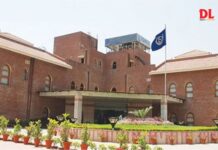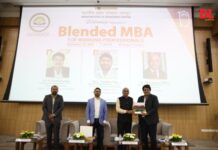Laptop for students pursuing
higher education Indian students pursuing higher education may soon be provided with laptops going by the recommendations of the Oversight Committee. The Committee headed by former Karnataka Chief Minister Veerappa Moily, which went into the issue of preparing a roadmap for the implementation of 27 per cent reservation for OBCs in higher educationalinstitutions, has also suggested that teachers too should have laptops. The Committee in its final report submitted to the PMO said, every student and every teacher should be given such a device on an ownership basis and the process should be facilitated by bank loans. The report said the grand plan for technology deployment on campuses was aimed at preparing and providing them essentially digital infrastructure ready to be used by a “plugged in, digital savvy-generation” called “net-Gen”.
IIT among world’s 100 best
universities According to the rankings compiled by the Times Higher ducation Supplement, India’s premier science and technology education center Indian Institute of Technology (IIT) is ranked No.57 in the global list. American and British universities comprised nearly half of the top 100 universities in the world. United States led the way with 33 universities in the top 100, while Britain ranked second with 15. China and India, the world’s two most populous countries, had two apiece, along with Singapore, New Zealand and Belgium. Harvard University in Massachusetts topped the poll, with Cambridge and Oxford in England coming second and third.
Akshara maps Indian schools
Karnataka Learning Partnership (KLP), an Akshara Foundation and Sarva Shiksha Abhiyaan initiative, has launched a Google-powered GIS map of Indian city Bangalore covering 1400 Government schools. The GIS mapping gives a complete picture of the literacy status among the children between second to seventh standard students. It was found that out of 1,83,000 students, 46 per cent of the students were unable to read fluently. The entire information captured in the GIS map is available on the website arnatakalearningpartnership.org. The map gives details of number of students, teachers in each school, the statistics and charts on the percentage of students who can read and who cannot read.
Students in India can now get
to work with robots With the support of a major initiative by the European Union, Indian institutions can now aim at taking their levels of learning and experimentation to higher levels, besides furthering their research in robotic and systems engineering. The International Virtual Laboratory in echatronics is a project that is getting nearly 500,00 Euros from the EU under the uropean Union – India Cross Cultural Programme (EICCP). At present, their Indian links are with the Chennai-based Anna University and the Madurai-based Thiagarajar College of Engineering. The main objective of the project is to jointly develop an International ‘Virtual’ Mechatronics laboratory, pecialising in robotics and telematics, with facilities physically present in India and Europe but virtually available to students at each university. This virtual laboratory can be used for teleeduca ion and research.
IIT to provide satellite-based
education to engineering colleges The faculty of Indian Institute of Technology, Kanpur, would provide education via satellite to various technical and engineering institutes in Uttar Pradesh. The project has got the green signal from the state government and a team of professors from IIT and Harcort Butler Technical Institute (HBTI), kanpur, are busy giving final shape to it. The faculty members will deliver lectures and answer queries of students sitting even at far-flung areas using video-conferencing technology. 15 ngineering institutions of the state will be taken up in the first phase of the project out of which 10 colleges will be from the private sector and the emaining government run institutions.
Translation industry has vast potential in India
The translation industry has the potential to generate more than 500,000 jobs in India, and necessary recommendations would be made to exploit the potential, says Knowledge Commission Chairman Sam Pitroda. Pitroda said the entire education system in India needed a complete overhauling – right from governmentrun schools to institutions of higher education – since education was becoming a privilege for the few who could afford it. He added that the
A unique educational project for students
Many of these children will be seeing something outside their villages and small towns for the first time. The Chinnara Suvarna Karnataka Darshana, a free educational tour programme under the universal primary education project,Sarvashiksha Abhiyan will help 11,750 children from Scheduled Castes and Schools in boats, brick kilns Education was never so innovative: schools in fishing boats, mobile schools in brick kilns; programmes like Meena campaign, Ujasbhani and Diwali camp for girl’s education, special teachers for children with disabilities. These and many more innovations made by four-year-old Sarva Shiksha Abhiyan to achieve universalisation of elementary ducation have been documented by IIMAhmedabad. The 91-page document highlights best practices and innovations done by Andhra Pradesh, Delhi, Gujarat, Haryana, Karnataka, Kerala, Madhya Pradesh, Maharashtra, Orissa, Tamil Nadu, UP, Uttaranchal and West Bengal. The study has found that the SSA has met with considerable success quantitatively if not qualitatively. While quality remains an area of concern, the SSA has been able to bridge the enrolment, retention and achievement gaps between the sexes and among social groups.
According to the IIM-A study titled ‘Shiksha Sangam: Innovations under the SSA,’ the out-of-school population had come down from 28.5 per cent of the six-to-14 year age group in 2001 to 6.94 per cent by the end of 2005. Dropout rates at the primary level stands at about 12 per cent and 190 of the 400 districts were showing a declining trend in 2005-2006. Scheduled Tribes, this year. Many will be girls. The tour programme has been on since 2004-05, and close to 457 batches including 23,000 children have already enjoyed the travel experience. The children are given a diary to note down their impressions and there are competitive events too during the tours with prizes to be won. Community radio license at last opens up for NGOs The Community radio opening up will allow NGOs to apply for licenses without a license fee and to carry five minutes of advertising per hour of broadcasting. First, non-governmental organisations with a record of at least three years of community service will be permitted to apply for licenses, and these will be given free of cost. It will still be an enormously centralised process. Having decided to open up radio frequencies to the NGO sector enabling provisions are also being worked out. The frequencies that have been identified to begin will be 90.4, 90.8 and 91.2 MHZ, or thereabouts.
























